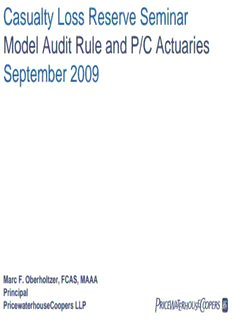
Model Audit Rule and P/C actuaries - Casualty Actuarial Society PDF
Preview Model Audit Rule and P/C actuaries - Casualty Actuarial Society
Casualty Loss Reserve Seminar Model Audit Rule and P/C Actuaries September 2009 Marc F. Oberholtzer, FCAS, MAAA Principal PwC PricewaterhouseCoopers LLP Agenda/Contents Overview of Model Audit Rule and Controls Testing Process, Risks and Controls in Loss Reserving Related Topics Section one Overview of Model Audit Rule and Controls Testing Process, Risks and Controls in Loss Reserving Related Topics Overview of Model Audit Rule and Controls Testing Model Audit Rule Selected highlights: • Upcoming statutory requirement in the US • Effective no earlier than January 2010 (varies by state based on when it is adopted) • Contains requirements related to financial statement audits of companies, including: - Independent CPA qualifications - Communication of internal control related matters - Audit committee requirements September 2009 PricewaterhouseCoopers Slide 4 Overview of Model Audit Rule and Controls Testing Model Audit Rule (continued) Also contains an attestation requirement regarding controls: • Certain companies must file an annual attestation regarding the effectiveness of their internal controls over financial reporting • Similar to Sarbanes-Oxley Section 404 attestation of internal controls by management September 2009 PricewaterhouseCoopers Slide 5 Overview of Model Audit Rule and Controls Testing What is Sarbanes-Oxley Section 404? Sarbanes-Oxley Act of 2002, Section 404, which was effective at year-end 2004 (accelerated filers) • Current requirement for public companies in the US • Requires management and independent accountant to provide attestation as to the effectiveness of the control framework that supports the company’s consolidated financial reporting • Generally resulted in improved loss reserving processes, controls and documentation September 2009 PricewaterhouseCoopers Slide 6 Overview of Model Audit Rule and Controls Testing What have we observed several years into 404? Some companies embraced the value of a strong control environment, other companies tended to be minimalists Benefits from having a strong control environment: • Greater efficiency in operation • Reduced risk of reserve misstatement • Reduced likelihood of surprises • Few or no deficiencies in controls • More effective and more efficient external audit • Smoother regulatory exam September 2009 PricewaterhouseCoopers Slide 7 Overview of Model Audit Rule and Controls Testing Management Report on Internal Controls Summary of new reporting requirements: • Annually, each insurance company or group will provide a report to their domiciliary insurance department with a report on internal controls over the statutory financial statement process • Report is signed by CEO and CFO • Smaller companies are exempt (i.e., only impacts companies with gross written premium of at least $500 million) • Evaluation and reporting requirements may vary depending on whether or not the company is: - Already compliant with 404 - Not already 404 compliant September 2009 PricewaterhouseCoopers Slide 8 Overview of Model Audit Rule and Controls Testing US Statutory Model Audit Rule and Section 404 Some notable differences: • Unlike Section 404, an auditor attestation of the effectiveness of internal controls is not required under the Model Audit Rule • Level of documentation and amount of testing under the Model Audit Rule may be subject to somewhat more management judgment than under Section 404 • Focus under Model Audit Rule for statutory reporting process, while Section 404 focuses on the consolidated financial statements September 2009 PricewaterhouseCoopers Slide 9 Section two Overview of Model Audit Rule and Controls Testing Process, Risks and Controls in Loss Reserving Related Topics
Description: